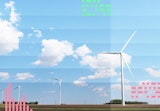Chapter.03/06
The History of the Internet of Things
The History of the Internet of Things
Chapter 03/06
The History of the Internet of Things
Snapshot
Learn about the history of the technological innovations that paved the way for the internet of things (IoT). Discover the milestones in the development of the IoT, from the Apollo moon missions to IBM’s Smarter Planet initiative.
Key Terms:
- Apollo Guidance Computer
- Tim Berners-Lee
- RFID
- Kevin Ashton
- Smart grid
- Android Things
- Distributed denial of service
The Internet of Things (IoT) is a rapidly evolving field of technology, but its roots have been decades in the making.
Starting with embedded systems and arriving at today’s enormous network of internet-connected smart devices, the IoT as we know it today was built on a strong backbone of existing tech. With the advent of cloud computing and Wi-Fi connectivity, the IoT became what it is today—and tomorrow, it will continue to evolve as new capabilities are developed. Take a look at where the IoT came from and where the future may take it. view citation[1]
IoT Through the Years
Explore and learn more about big data’s growth and impact with these important milestones and key events in the history of big data and data analytics.
1965: Apollo Guidance Computer
The Apollo Guidance Computer (AGC), a digital computer produced by MIT for NASA’s Apollo moon-landing program, is installed on each Apollo command module and lunar module. The AGC was one of the first computers to contain integrated circuits and is recognized as one of the first modern embedded systems. view citation[2] Embedded systems are not necessarily internet-connected, but they have become integral components of today’s IoT devices.
1968: N M Electronics
N M Electronics—which would later be known as Integrated Electronics, or Intel—is founded by Gordon Moore and Robert Noyce. view citation[3] Intel later becomes a commercial giant in IoT development.
1973: The First Mobile Phone Call
Motorola senior engineer Martin Cooper calls a rival telecommunications company and tells them he is making the call from a mobile phone. This is the first mobile phone call in history, made on a handset that weighed 2.4 pounds. view citation[4]

1975: Personal Computers
The first personal computers are sold in kits for just over $400. The MITS Altair 8800 and the IMSAI 8080 both used the Intel 8080 central processing unit. view citation[5]
1982: The Origins of the Internet
Vinton Cerf, a manager at the U.S. Defense Advanced Research Projects Agency, and Bob Kahn begin working on the first versions of the transmission control protocol (TCP) and the internet protocol (IP). TCP/IP will become the universal language of the internet, allowing computers to communicate over long distances. view citation[6]
1983: Gadgets Advance
The first home computer with touchscreen capability, Hewlett-Packard’s HP-150, becomes available for purchase. The same year, Motorola also releases its first commercial mobile phone, the Motorola DynaTAC 8000X. view citation[7]
1989: The World Wide Web
Tim Berners-Lee invents the World Wide Web, allowing “hypertext documents” to be viewed by “browsers” using a client-server architecture. view citation[8]
1995: Internet at Home
Internet access begins to be sold commercially to consumers. view citation[9]

1999: IoT is Born
The Auto-ID Center is founded at MIT. The Auto-ID Center lays much of the groundwork for the standardization of radio frequency identification (RFID) technology and germinates the idea for what would become IoT devices. view citation[10] RFID technology uses electromagnetic fields to automatically identify and track tags attached to objects, such as devices, clothing, and pharmaceuticals, or implanted in pets and even people. view citation[11] Kevin Ashton, an executive at Procter & Gamble and a co-founder of MIT’s Auto-ID Center, coins the term “internet of things” to describe RFID technology.
2007: Smart Grid
The first official definition of the term “smart grid” is signed into U.S. law via the Energy Independence and Security Act of 2007. A smart grid is a connected electrical grid that includes smart meters, smart appliances, renewable energy resources and energy-efficient resources. view citation[12]

2008: IBM’s “Smarter Planet”
IBM launches its Smarter Planet initiative, which becomes the overarching framework for IBM’s growth strategy. view citation[13] The Smarter Planet initiative is based on the idea that a new generation of intelligent systems and technologies—more powerful and accessible than ever before—can be put to use for profound impact and to encourage further thinking, through smarter power grids, smarter food systems, smarter water, smarter health care, smarter traffic systems, and sophisticated analytics and algorithms to make sense of it all.
2004: Distributed Computing
Google publishes a paper describing a distributed storage system, called BigTable, for handling big data. Apache Software launches its own distributed computing solution called Hadoop in 2008. Distributed computing makes it possible to run NoSQL databases that are faster and are easier to scale than relational databases.
2008: Android
The first Android phone, the T-Mobile G1, is released to market. The code used to develop the Android operating system is released as open source. view citation[14] All mobile developers can now create apps on the Android platform, allowing for many IoT devices to be connected to the Android network.
2010: China’s Big Plan
China incorporates IoT research into its 12th five-year plan. view citation[15]
2010: Connected Devices Rule the World
The number of devices connected to the internet reaches 12.5 billion, as the world’s human population increases to 6.8 billion. This is the first time in history that the number of internet-connected devices exceeds the number of humans connected to the internet. view citation[16]
2015: Google’s “Android Things”
Google announces that its developer toolkit for IoT, Android Things, will be released as open source, so all IoT device and app manufacturers can build their products on this platform. view citation[17]

2016-2018: Botnets Attack!
Ongoing distributed denial of service attacks are waged by botnets, compromising poorly secured IoT devices.
2018: The Fourth Industrial Revolution
Mobile World Congress 2018, the world’s largest exhibition for the mobile industry, is held in Barcelona, Spain. Themes include the Fourth Industrial Revolution, featuring the growth of IoT and preparation for an automated future. view citation[18]
By 2020: IoT Everywhere
Gartner predicts IoT will grow to 26 billion units installed, a 30-fold increase from the fewer than 1 billion IoT units that were installed in 2009. view citation[19] Cisco predicts 50 billion units installed in the same time frame. view citation[20]

References
-
“Embedded In Our Society: A History Of Embedded Operating Systems.” Hughes Systique. February 2014. View Source
-
“Introduction to Embedded Systems.” Miguel Jimenez. 2014. View Source
-
“Intel Timeline: A History of Innovation.” Intel. View Source
-
“The History of Mobile Phones From 1973 To 2008: The Handsets That Made It ALL Happen.” Know Your Mobile. June 2019. View Source
-
“MITS Altair 8800.” OldComputers.net. View Source
-
“What is the Internet and Who Invented It?” plusnet. View Source
-
“Embedded In Our Society: A History Of Embedded Operating Systems.” Hughes Systique. February 2014. View Source
-
“WorldWideWeb: Proposal for a HyperText Project.” Tim Berners-Lee. November 1990. View Source
-
“What is the Internet and Who Invented It?” plusnet. View Source
-
“How the Next Evolution of the Internet Is Changing Everything.” Cisco. April 2011. View Source
-
“Why the Internet of Things is called Internet of Things: Definition, history, disambiguation.” IoT Analytics. December 2014. View Source
-
“What is the Smart Grid?” SmartGrid.gov. View Source
-
“Smarter Planet.” IBM. View Source
-
“Gadget Rewind 2008: T-Mobile G1 (HTC Dream).” Engadget. June 2014. View Source
-
“The role of Internet of Things in China’s 12th Five Year Plan.” DigiTimes. October 2011. View Source
-
“How the Next Evolution of the Internet Is Changing Everything.” Cisco. April 2011. View Source
-
“Google’s IoT platform Android Things is open to all developers.” Engadget. May 2018. View Source
-
“Event Themes.” Mobile World Congress. View Source
-
“Gartner Says 8.4 Billion Connected “Things” Will Be in Use in 2017, Up 31 Percent From 2016.” Gartner. February 2017. View Source
-
“How the Next Evolution of the Internet Is Changing Everything.” Cisco. April 2011. View Source
Next Section
The Internet of Things in Your Home and the World
Chapter 04 of 06
Learn how the internet of things (IoT) permeates our daily lives and the wider world.